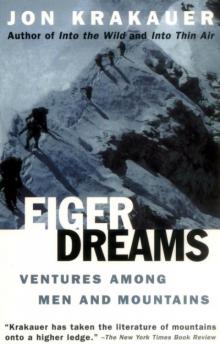


Eiger Dreams: Ventures Among Men and Mountains
Jon Krakauer

JON KRAKAUER
Jon Krakauer is the author of Into the Wild and Into Thin Air: A Personal Account of the Mt. Everest Disaster. He writes for many national magazines and newspapers, including Outside, where he is a contributing editor. A winner of the American Alpine Club Literary Award, he was also named as a finalist for a National Magazine Award. He and his wife live in Seattle, Washington.
JON KRAKAUER
For LINDA, with thoughts of Green Mountain Falls, the Wind Rivers, and Roanoke Street.
The oldest, most widespread stories in the world are adventure stories, about human heroes who venture into the myth-countries at the risk of their lives, and bring back tales of the world beyond men . . . It could be argued . . . that the narrative art itself arose from the need to tell an adventure; that man risking his life in perilous encounters constitutes the original definition of what is worth talking about.
Paul Zweig
THE ADVENTURER
Having an adventure shows that someone is incompetent, that something has gone wrong. An adventure is interesting enough in retrospect, especially to the person who didn't have it; at the time it happens it usually constitutes an exceedingly disagreeable experience.
Vilhjalmur Stefansson
MY LIFE WITH THE ESKIMO
Author's Note A x
1 EIGER DREAMS A I
2 GILL A 14
A27 3 VALDEZ ICE
4 ON BEING TENTBOUND A 42
S1 5 THE FLYBOYS OF TALKEETNA L
6 CLUB DENALI A 64
7 CHAMONIX L 84
8 CANYONEERING A 103
9 A MOUNTAIN HIGHER THAN EVEREST? 0116
10 THE BURGESS BOYS A 130
11 A BAD SUMMER ON K2 0149
12 THE DEVILS THUMB A 163
MOUNTAIN CLIMBING IS COMPREHENDED DIMLY, IF AT ALL, BY MOST of the nonclimbing world. It's a favorite subject for bad movies and spurious metaphors. A dream about scaling some high, jagged alp is something a shrink can really sink his teeth into. The activity is wrapped in tales of audacity and disaster that make other sports out to be trivial games by comparison; as an idea, climbing strikes that chord in the public imagination most often associated with sharks and killer bees.
It is the aim of this book to prune away some of this overgrown mystique-to let in a little light. Most climbers aren't in fact deranged, they're just infected with a particularly virulent strain of the Human Condition.
In the interest of truth in packaging, I should state straightaway that nowhere does this book come right out and address the central question-Why would a normal person want to do this stuff?head on; I circle the issue continually, poke at it from behind with a long stick now and then, but at no point do I jump right in the cage and wrestle with the beast directly, mano a mano. Even so, by the end of the book I think the reader will have a better sense not only of why climbers climb, but why they tend to be so goddamn obsessive about it.
I trace the roots of my own obsession back to 1962. I was a fairly ordinary kid growing up in Corvallis, Oregon. My father was a sensible, rigid parent who constantly badgered his five children to study calculus and Latin, keep their noses to the grindstone, fix their sights early and unflinchingly on careers in medicine or law. Inexplicably, on the occasion of my eighth birthday this strict taskmaster presented me with a pint-size ice axe and took me on my first climb. In retrospect I can't imagine what the old man was thinking; if he'd given me a Harley and a membership in the Hell's Angels he couldn't have sabotaged his paternal aspirations any more effectively.
By the age of eighteen climbing was the only thing I cared about: work, school, friendships, career plans, sex, sleep-all were made to fit around my climbing or, more often, neglected outright. In 1974 my preoccupation intensified further still. The pivotal event was my first Alaskan expedition, a month-long trip with six companions to the Arrigetch Peaks, a knot of slender granite towers possessed of a severe, haunting beauty. One June morning at 2:30 A.M., after climbing for twelve straight hours, I pulled up onto the summit of a mountain called Xanadu. The top was a disconcertingly narrow fin of rock, likely the highest point in the whole range. And ours were the first boots ever to step upon it. Far below, the spires and slabs of the surrounding peaks glowed orange, as if lit from within, in the eerie, nightlong dusk of the arctic summer. A bitter wind screamed across the tundra from the Beaufort Sea, turning my hands to wood. I was as happy as I'd ever been in my life.
I graduated from college, by the skin of my teeth, in December, 1975. I spent the next eight years employed as an itinerant carpenter and commercial fisherman in Colorado, Seattle, and Alaska, living in studio apartments with cinder-block walls, driving a hundreddollar car, working just enough to make rent and fund the next climbing trip. Eventually it began to wear thin. I found myself lying awake nights reliving all the close scrapes I'd had on the heights. Sawing joists in the rain at some muddy construction site, my thoughts would increasingly turn to college classmates who were raising families, investing in real estate, buying lawn furniture, assiduously amassing wealth.
I resolved to quit climbing, and said as much to the woman with whom I was involved at the time. She was so taken aback by this announcement that she agreed to marry me. I'd grossly underestimated the hold climbing had on me, however; giving it up proved much more difficult than I'd imagined. My abstinence lasted barely a year, and when it ended it looked for a while like the connubial arrangement was going to end with it. Against all odds, I somehow managed to stay married and keep climbing. No longer, however, did I feel compelled to push things right to the brink, to see God on every pitch, to make each climb more radical than the last. Today I feel like an alcoholic who's managed to make the switch from week-long whiskey benders to a few beers on Saturday night. I've slipped happily into alpine mediocrity.
My ambitions as a climber have been inversely proportional to my efforts as a writer. In 1981 I sold my first article to a national magazine; in November, 1983, I bought a word processor, took off my tool belt for what I hoped would be the last time, and began writing for a living. I've been at it full-time ever since. These days more and more of my assignments seem to be about architecture, or natural history, or popular culture-I've written about fire walking for Rolling Stone, wigs for Smithsonian, neo-Regency design for Architectural Digest-but mountaineering stories continue to be nearest and dearest to my heart.
Eleven of the twelve essays collected between these covers were initially written for magazines (the closing story, "The Devils Thumb," was written specifically for this book). As such, they have benefited-and occasionally suffered-from the attentions of a small army of editors and fact checkers at the publications that first put the articles into print. I am especially indebted to Mark Bryant and John Rasmus at Outside, and Jack Wiley, Jim Doherty, and Don Moser at Smithsonian, for the invaluable contributions they've made to the best of these pieces. All five men are accomplished writers as well as superb editors, and it showed in the sensitivity and restraint they demonstrated time and time again in their efforts to steer me right when I was going wrong.
I also owe thanks to Larry Burke, Mike McRae, Dave Schonauer, Todd Balf, Alison Carpenter Davis, Marilyn Johnson, Michelle Stacey, Liz Kaufmann, Barbara Rowley, Susan Campbell, Larry Evans, Joe Crump, Laura Hohnhold, Lisa Chase, Sue Smith, Matthew Childs, and Rob Story at Outside; Caroline Despard, Ed Rich, Connie Bond, Judy Harkison, Bruce Hathaway, Tim Foote, and Frances Glennon at Smithsonian; Phil Zaleski and David Abramson at New Age Journal; H. Adams Carter at The American Alpine Journal; Michael Kennedy and Alsion Osius at Climbing; Ken Wilson at Mountain; Peter Burford for his hand in shaping this collection; Debora
h Shaw and Nick Miller for their hospitality; my agent John Ware; and fellow freelancer Greg Child, with whom I collaborated on an early draft of "A Bad Summer on K2."
For sharing a rope during some memorable days in the mountains I'm grateful to Fritz Wiessner, Bernd Arnold, David Trione, Ed Trione, Tom Davies, Marc Francis Twight, Mark Fagan, Dave Jones, Matt Hale, Chris Gulick, Laura Brown, Jack Tackle, Yvon Chouinard, Lou Dawson, Roman Dial, Kate Bull, Brian Teale, John Weiland, Bob Shelton, Nate Zinsser, Larry Bruce, Molly Higgins, Pam Brown, Bill Bullard, Helen Apthorp, Jeff White, Holly Crary, Ben Reed, Mark Rademacher, Jim Balog, Mighty Joe Hladick, Scott Johnston, Mark Hesse, Chip Lee, Henry Barber, Pete Athans, Harry Kent, Dan Cauthorn, and Robert Gully.
Most of all, I'd like to thank Lew and Carol Krakauer for having the poor judgment to take their eight-year-old son up the South Sister; Steve Rottler for hiring and rehiring me over so many years in Boulder, Seattle, and Port Alexander; Ed Ward, the most naturally gifted climber I have ever seen, who showed me how to climb hard and stay alive doing it; David Roberts, who introduced me to Alaska and taught me how to write; and Linda Mariam Moore, my best editor and closest pal.
IN THE EARLY MOMENTS OF The Eiger Sanction, CLINT EASTWOOD saunters into the dimly lit headquarters of C-2 to find out who he is supposed to assassinate next. Dragon, the evil albino who runs the CIA-like organization, tells Eastwood that although the agency does not yet have the target's name, they have discovered that "our man will be involved in a climb in the Alps this summer. And we know which mountain he will climb: the Eiger."
Eastwood has no trouble guessing which route-"The North Face, of course"-and allows that he is familiar with that particular alpine wall: "I tried to climb it twice, it tried to kill me twice .. . Look, if the target's trying to climb the Eiger, chances are my work will be done for me."
The problem with climbing the North Face of the Eiger is that in addition to getting up 6,000 vertical feet of crumbling limestone and black ice, one must climb over some formidable mythology. The trickiest moves on any climb are the mental ones, the psychological gymnastics that keep terror in check, and the Eiger's grim aura is intimidating enough to rattle anyone's poise. The epics that have taken place on the Nordwand have been welded into the world's collective unconscious in grisly detail by more than two thousand newspaper and magazine articles. The dust jackets of books with titles such as Eiger: Wall of Death, remind us that the Nordwand "has defeated hundreds and killed forty-four ... Those who fell were found-sometimes years later-dessicated and dismembered. The body of one Italian mountaineer hung from its rope, unreachable but visible to the curious below, for three years, alternately sealed into the ice sheath of the wall and swaying in the winds of summer."
The history of the mountain resonates with the struggles of such larger-than-life figures as Buhl, Bonatti, Messner, Rebuffat, Ter- ray, Haston, and Harlin, not to mention Eastwood. The names of the landmarks on the face-the Hinterstoisser Traverse, the Ice Hose, the Death Bivouac, the White Spider-are household words among both active and armchair alpinists from Tokyo to Buenos Aires; the very mention of these places is enough to make any climber's hands turn clammy. The rockfall and avalanches that rain continuously down the Nordwand are legendary. So is the heavy weather: Even when the skies over the rest of Europe are cloudless, violent storms brew over the Eiger, like those dark clouds that hover eternally above Transylvanian castles in vampire movies.
Needless to say, all this makes the Eiger North Face one of the most widely coveted climbs in the world.
The Nordwand was first climbed in 1938, and since then it has had more than 150 ascents, among them a solo climb in 1983 that took all of five and a half hours, but don't try to tell Staff Sergeant Carlos J. Ragone, U.S.A.F., that the Eiger has become a scenic cruise. Last fall, Marc Twight and I were sitting outside our tents above Kleine Scheidegg, the cluster of hotels and restaurants at the foot of the Eiger, when Ragone strolled into camp under a bulging pack and announced that he had come to climb the Nordwand. In the discussion that ensued, we learned that he was AWOL from an air base in England. His commanding officer had refused to grant Ragone a leave when the C.O. learned what Ragone intended to do with it, but Ragone had left anyway. "Trying this climb will probably cost me my stripes," he said, "but on the other hand, if I get up the mother they might promote me."
Unfortunately, Ragone didn't get up the mother. September had gone down in the Swiss record books as the wettest since 1864, and the face was in atrocious condition, worse even than usual, plastered with rime and loaded with unstable snow. The weather forecast was for continuing snow and high wind. Two partners who were supposed to rendezvous with Ragone backed out because of the nasty conditions. Ragone, however, was not about to be deterred by the mere lack of company. On October 3 he started up the climb by himself. On the lower reaches of the face, near the top of a buttress known as the First Pillar, he made a misstep. His ice axes and crampons sheared out of the rotten ice, and Ragone found himself airborne. Five hundred vertical feet later he hit the ground.
Incredibly, his landing was cushioned by the accumulation of powder snow at the base of the wall, and Ragone was able to walk away from the fall with no more damage than bruises and a crimp in his back. He hobbled out of the blizzard into the Babnbof buffet, asked for a room, went upstairs, and fell asleep. At some point during his tumble to the bottom of the wall he had lost an ice axe and his wallet, which contained all his identification and money. In the morning, when it was time to settle his room bill, all Ragone could offer for payment was his remaining ice axe. The Babnbof manager was not amused. Before slinking out of Scheidegg, Ragone stopped by our camp to ask if we were interested in buying what was left of his climbing gear. We told him that we'd like to help him out, but we happened to be a little strapped for cash ourselves. In that case, Ragone, seeing as he didn't think he was going to feel like climbing again for a while, said he'd just give the stuff to us. "That mountain is a bastard," he spat, glancing up at the Nordwand one last time. With that, he limped off through the snow toward England to face the wrath of his C.O.
Like Ragone, Marc and I had come to Switzerland to climb the Nordwand. Marc, eight years my junior, sports two earrings in his left ear and a purple haircut that would do a punk rocker proud. He is also a red-hot climber. One of the differences between us was that Marc wanted very badly to climb the Eiger, while I wanted very badly only to have climbed the Eiger. Marc, understand, is at that age when the pituitary secretes an overabundance of those hormones that mask the subtler emotions, such as fear. He tends to confuse things like life-or-death climbing with fun. As a friendly gesture, I planned to let Marc lead all the most fun pitches on the Nordwand.
Unlike Ragone, Marc and I were not willing to go up on the wall until conditions improved. Due to the Nordwand's concave architecture, whenever it snows, few places on the wall are not exposed to avalanches. In summer, if things go well, it will typically take a strong party two days, maybe three, to climb the Nordwand. In the fall, with the shorter days and icier conditions, three to four days is the norm. To maximize our chances of getting up and down the Eiger without unpleasant incident, we figured we needed at least four consecutive days of good weather: one day to allow the buildup of new snow to avalanche off, and three to climb the face and descend the mountain's west flank.
Each morning during our stay at Scheidegg we would crawl out of our tents, plow down through the snowdrifts to the Bahnhof, and phone Geneva and Zurich to get a four-day weather forecast. Day after day, the word was the same: Continuing unsettled weather, with rain in the valleys and snow in the mountains. We could do nothing but curse and wait, and the waiting was awful. The Eiger's mythic weight bore down especially hard during the idle days, and it was easy to think too much.
One afternoon, for diversion, we took a ride on the train up to theJungraujoch, a cog railroad that runs from Kleine Scheidegg to a saddle high on the Eiger Jungfrau massif. This turned out to be a mistake. The railway trav
erses the bowels of the Eiger by way of a tunnel that was blasted through the mountain in 1912. Midway up the tracks there is an intermediate station with a series of huge windows that look out from the vertical expanse of the Nordwand.
The view from these windows is so vertiginous that barf bagsthe same kind they put in airplane seat-pockets-had been placed on the windowsills. Clouds swirled just beyond the glass. The black rock of the Nordwand, sheathed in frost feathers and sprouting icicles in the places where it overhung, fell away dizzyingly into the mists below. Small avalanches hissed past. If our route turned out to be anything like what we were seeing, we were going to find ourselves in serious trouble. Climbing in such conditions would be desperate if not impossible.
On the Eiger, constructions of the imagination have a way of blurring with reality, and the Eigerwand station was a little too much like a scene from a recurring dream I've been having for years in which I'm fighting for my life in a storm on some endless climb when I come upon a door set into the mountainside. The doorway leads into a warm room with a fireplace and tables of steaming food and a comfortable bed. Usually, in this dream, the door is locked.
A quarter-mile down the tunnel from the big windows of the midway station there is in fact a small wooden door-always unlocked-that opens out onto the Nordwand. The standard route up the wall passes very near this door, and more than one climber has used it to escape from a storm.
Such an escape, however, poses hazards of its own. In 1981, Mugs Stump, one of America's most accomplished alpinists, popped in through the door after a storm forced him to abort a solo attempt on the wall and started walking toward the tunnel entrance, about a mile away. Before he could reach daylight, he met a train coming up the tracks. The guts of the Eiger are hard black limestone that makes for tough tunneling, and when the tunnel was constructed the builders didn't make it any wider than they had to. It quickly became evident to Stump that the space between the cars and the tunnel walls was maybe a foot, give or take a few inches. The Swiss take great pride in making their trains run on time, and it also became evident that this particular engineer was not about to foul up his schedule simply because some damn climber was on the tracks. All Stump could do was suck in his breath, press up against the rock, and try to make his head thin. He survived the train's passing, but the experience was as harrowing as any of the close scrapes he'd had on the outside of the mountain.














